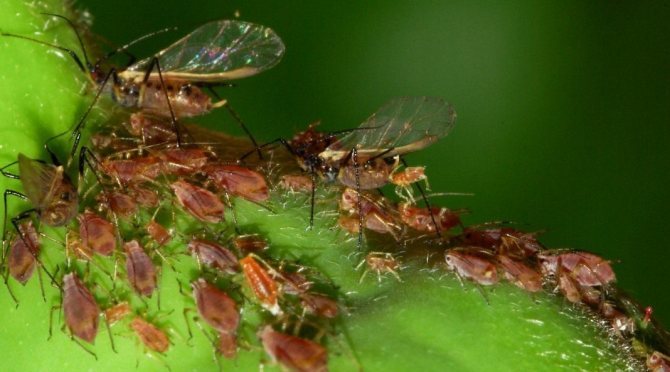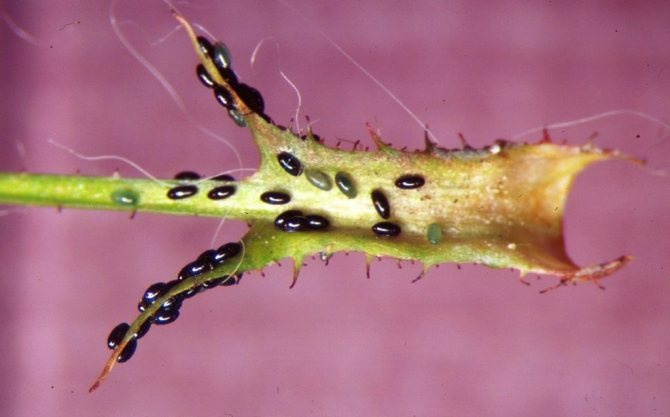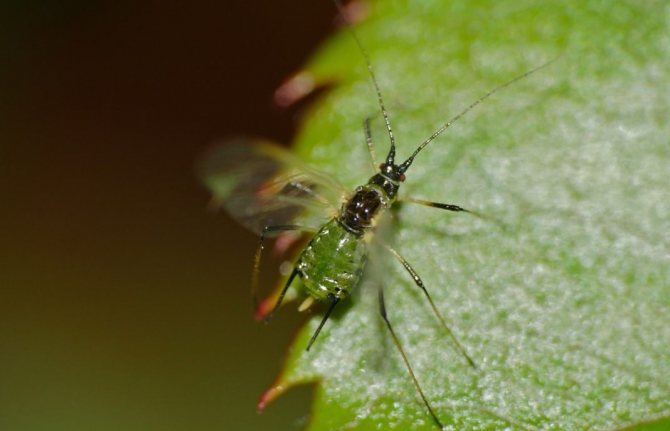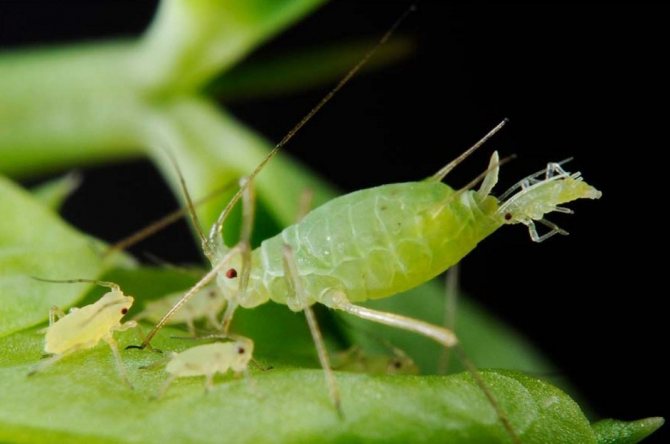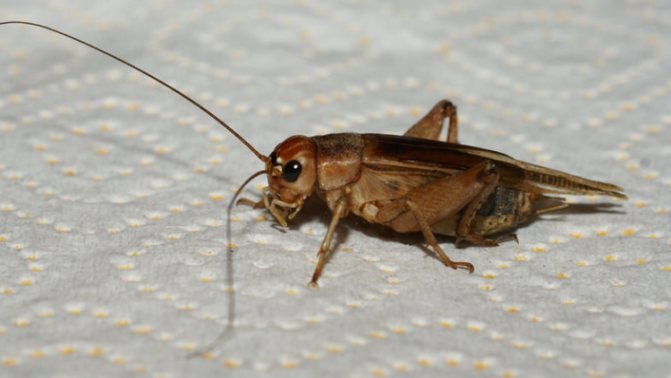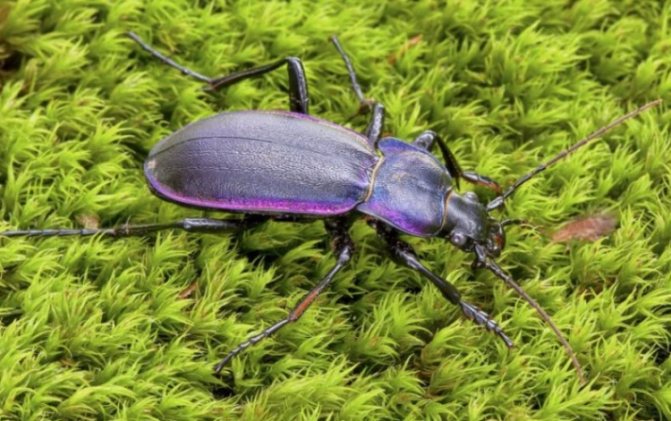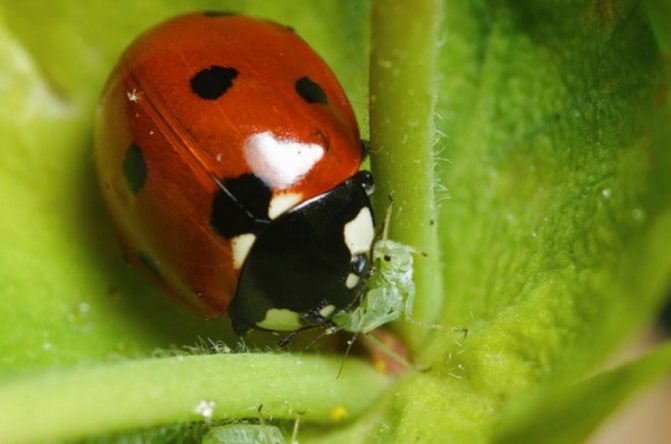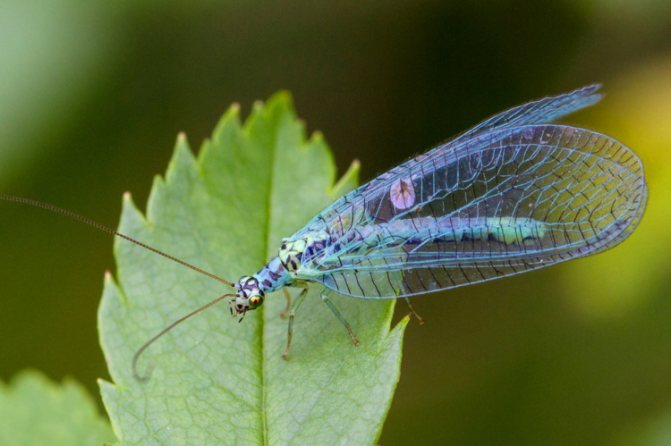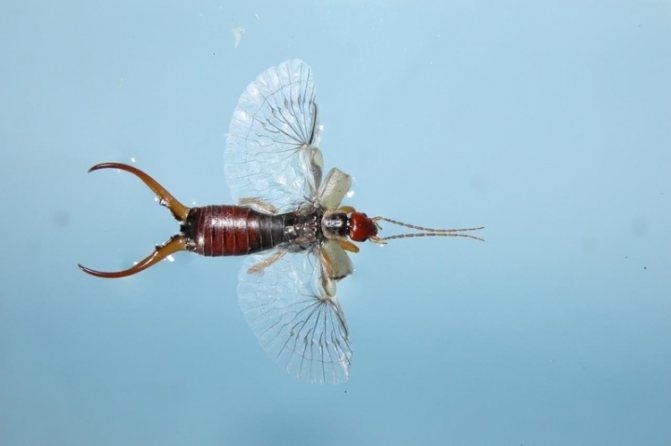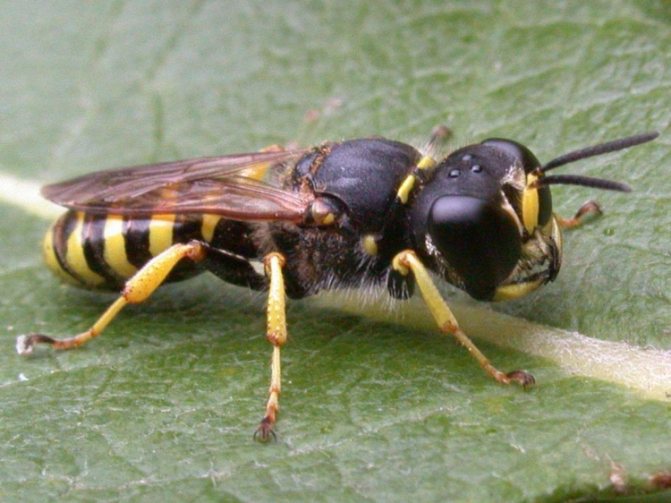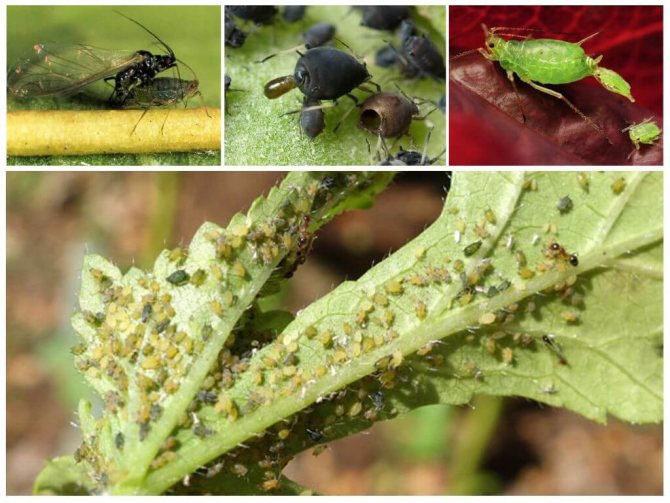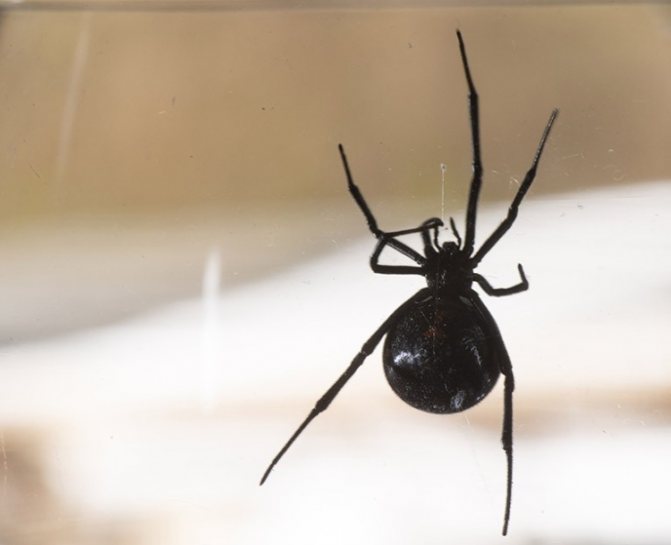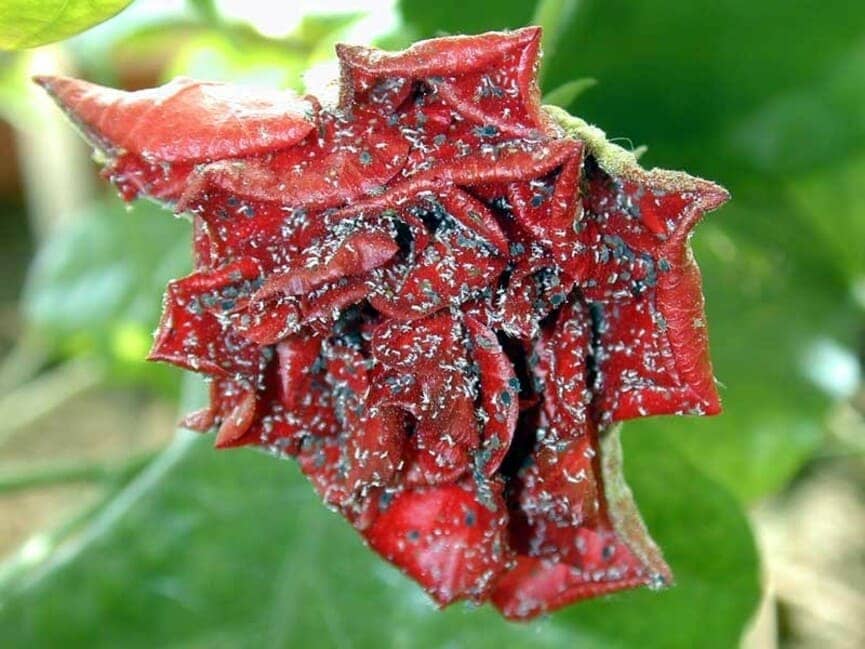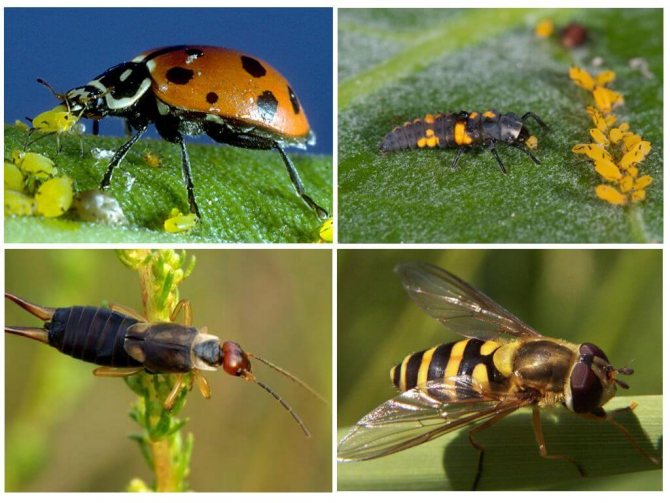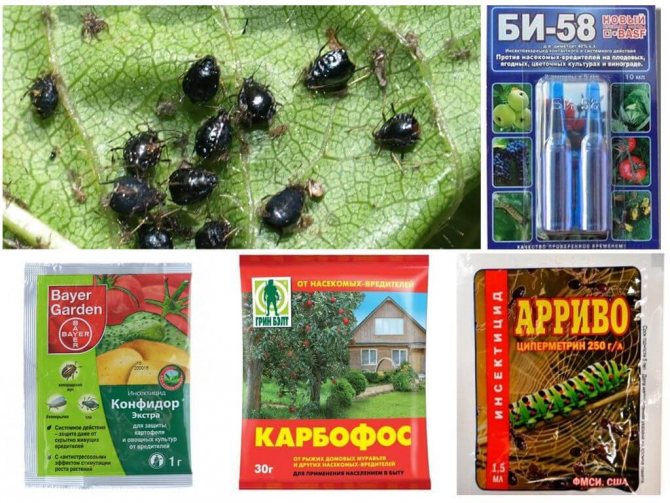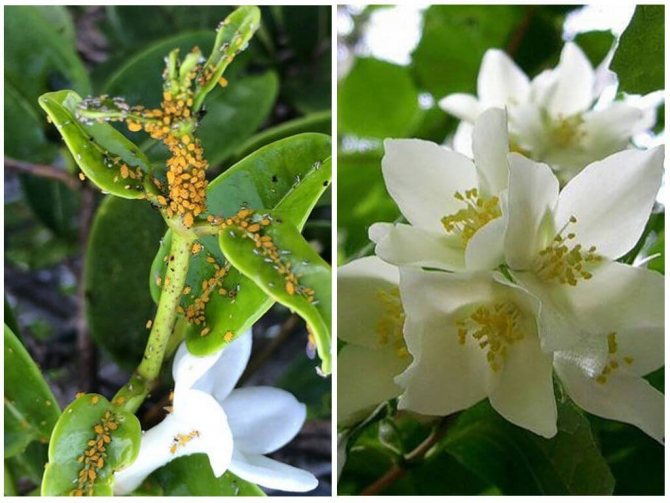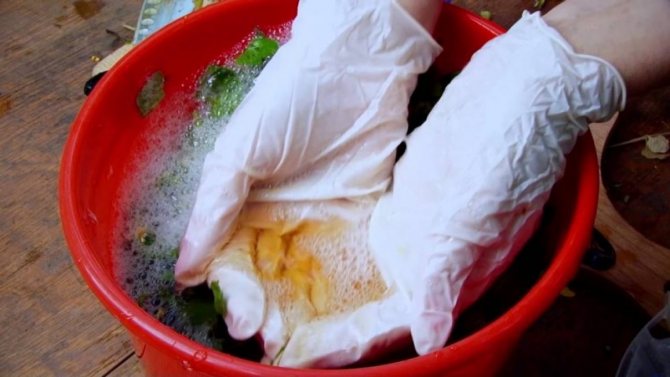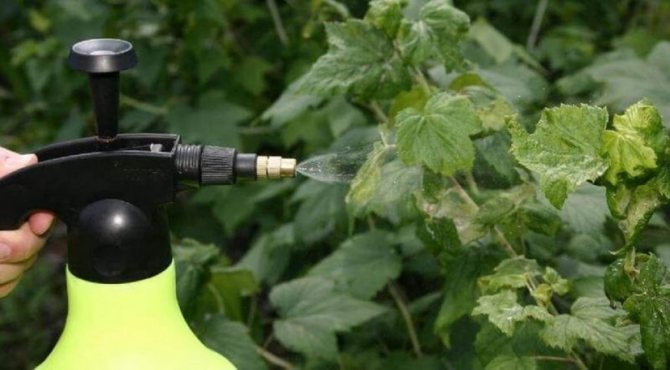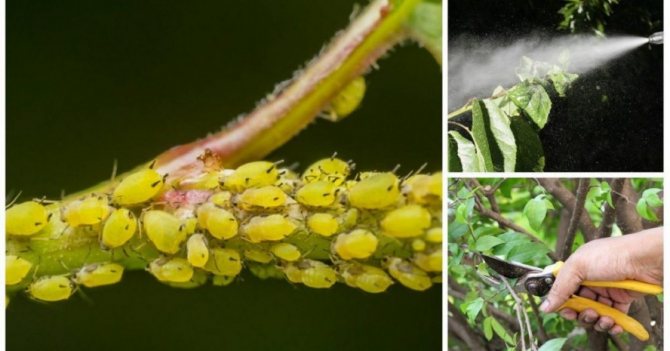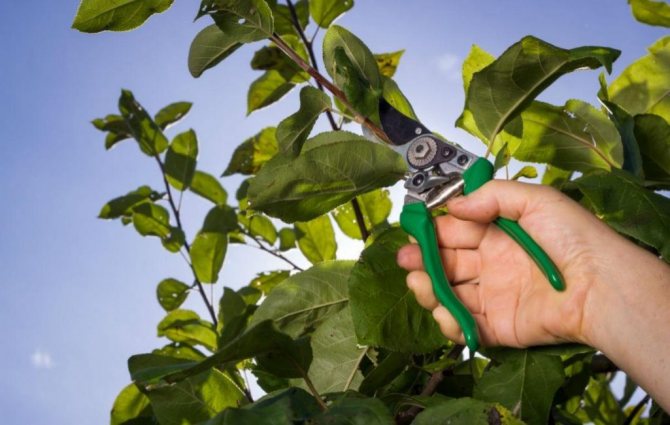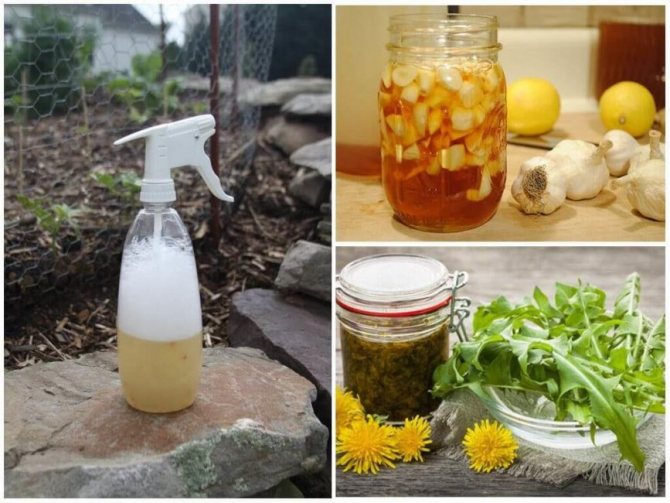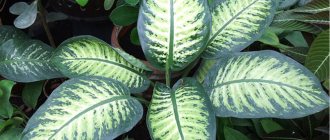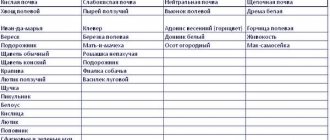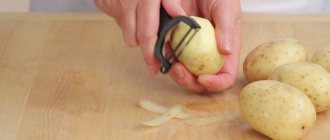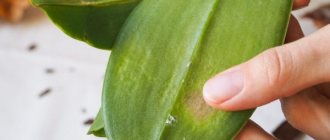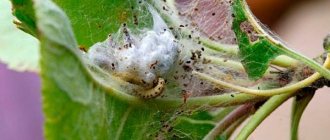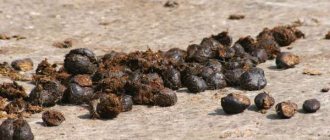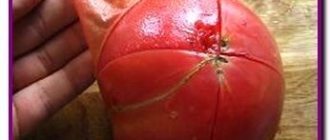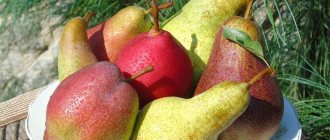The insect, known to gardeners and gardeners as aphids - an arthropod from the order of hemiptera, characterized by vegetarian eating habits, can be called one of the main dangers to the harvest of fruit and berry crops. Incredible, but true: not having an impressive size, this parasite is able to create colonies on an area of several hundred square meters. And in case of danger, he easily changes his place of residence, moving at a speed that is quite unexpected for the sedentary pests.
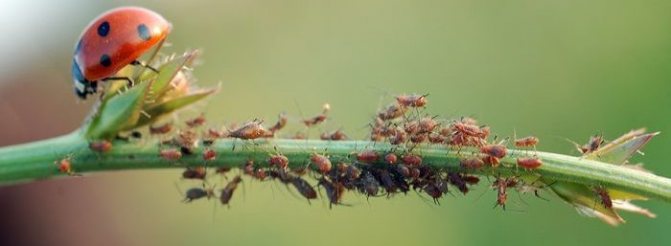
Where does aphid come from?
For the first time, faced with the appearance on the branches and leaves of plants of a swarming mass of light green color, to which ants show special attention, many gardeners recklessly let the situation take its course. As a result, where timely treatment for aphids could give a quick result due to the small number of the colony, subsequently it is necessary to conduct a protracted struggle with a whole horde of insects that are not ready to leave their habitat, which they rightfully consider theirs. It is worth noting that initially this parasite still lives in the wild. But as human activity decreases the area of forest tracts, their inhabitants begin to develop new territories. Some species of hemiptera insects can fly and move freely between territories, sometimes overcoming very impressive distances.
Prevention: what scares away aphids
How to get rid of aphids in the garden forever. Herbs with a characteristic odor that repel various pests will also become an excellent remedy for aphids. They are boiled and treated with plants, carefully sprinkling each planting. Experts recommend alternating the compositions of herbs so that aphids do not develop a stable immunity against them. The "unloved" by aphids herbs include:
- basil,
- marigold,
- mustard,
- peppermint,
- larkspur,
- coriander,
- catnip,
- nasturtium,
- sagebrush,
- fennel and some other plants.
What is the danger of a pest?
The danger posed by this miniature (and the body of an adult is, on average, 3 mm long) parasite, can be underestimated only before you manage to get to know him better. The initial development of colonies occurs latently, on the lower surface of the leaves of trees and shrubs. And the presence of uninvited guests most often becomes obvious after their number reaches certain (and very impressive) values. Why are these insects dangerous?
- Toxic damage to plant organs. The toxins released by the pest become the reason for the change in the appearance of the shoots, prevent pollination, the formation of ovaries and fruiting. And the leaves, under the influence of a dangerous neighbor, curl up and give the plant a very unaesthetic appearance.
- Stopping growth. The more numerous the colony is, the more dangerous its stay on the territory of the site will be. Signs that the problem has reached the scale of an epidemic are discoloration of the leaves, spotting. Unaesthetic plaque (honeydew secreted by the pest) interferes with the formation of chlorophyll and the passage of photosynthetic processes.And the plant itself becomes more vulnerable to damage by various types of mold and mildew.
- High risk of contracting viral diseases. Aphids carry dangerous diseases that can destroy those parts of plants that are not of interest to the pests themselves.
- Possible plant death. Increased vulnerability to any external influences and weakening of natural defenses can lead to freezing of shoots in winter or their complete death under the influence of insect attacks.
- The formation of galls - tumor neoplasms that cause tissue destruction and can lead to the death of stems in the future.
It is not surprising that with such a "track record" of exploits, the appearance of this insect on the site causes a very negative reaction among amateur gardeners. But self-processing of trees from aphids is most often carried out too late - with a significant growth of the colony, and does not bring significant results.
What does it look like?
Aphids are insects from the Hemiptera order, there are more than 4000 species, about 1000 species of aphids live within Europe.
These are miniature creatures, with a body length from 0.5 mm to 7 mm, but more often not more than 3 mm, the shape of the body resembles a drop, pointed at the rear end. Look at the photo on the right for what aphids look like.
Descriptions of insects vary. Depending on the conditions of existence, they can be wingless or have 2 pairs of transparent wings, with the rear pair always shorter than the front. Pictures with their images can be found below in this material. Aphids on leaves can completely destroy a tree or plant.
The color is very diverse - black, green, pink, red, or even an insect is completely transparent. The head has dark eyes and a pair of antennae.
Is there a useful We will find out aphids further.
Photo of aphids
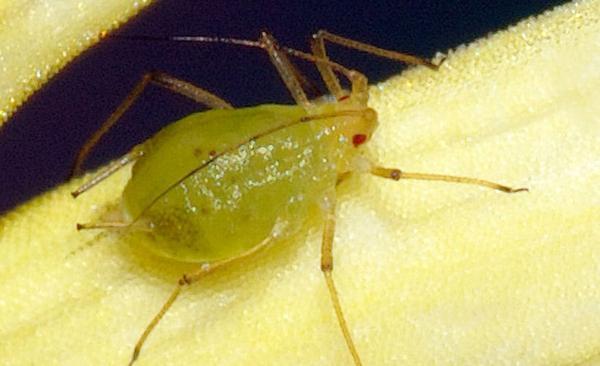

Features of life
What do you need to know about a pest in order to defeat it? First of all, it is worth studying the features of its reproduction and migration. In the case of aphids, it is necessary to remember that both winged and wingless insects can attack your garden, vegetable garden or indoor plants. Body color also depends on the species (and there are several thousand of them in nature). On the territory of Russia, individuals with a colorless (almost transparent), red, black, green or pink color are found. Each of them has paired antennae and eyes located in the front of the body.
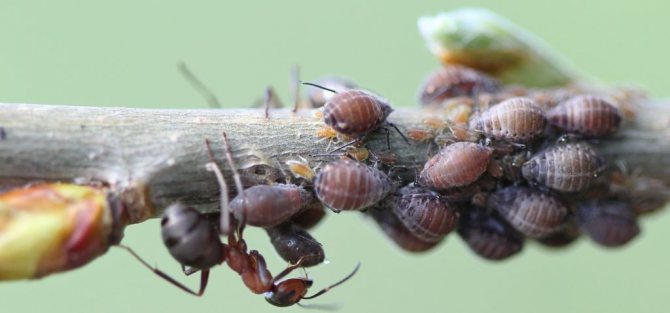

The reproduction processes of pests parasitizing on the surface of plant shoots are original. They wait out the winter inside the egg, laid in a place that is inaccessible to external threats. With the onset of heat, a female emerges from it, devoid of wings - the uterus, which gives birth to larvae (they appear already alive), the so-called "virgins".
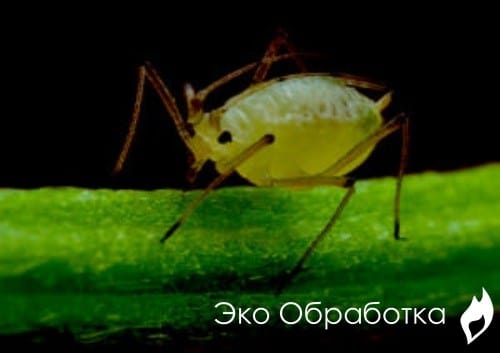

This name is due to the fact that only females are born, which also continue to reproduce female offspring without any participation of the male. The average lifespan of such individuals is 30 days, during which only one female can leave impressive offspring. And virgin aphids ripen for childbearing two weeks after their birth.
As the colony grows, winged females appear in the offspring, which carry out further migration. It is in them that the larvae of both sexes are born in the fall, which, when mating, lay eggs, which provide a new reproduction of offspring in the spring. In fact, just one queen that has established a colony can increase its population to several hundred thousand individuals over the summer. And such frightening statistics outline quite clear prospects for the orchards and vegetable gardens chosen by the parasite for repopulation.
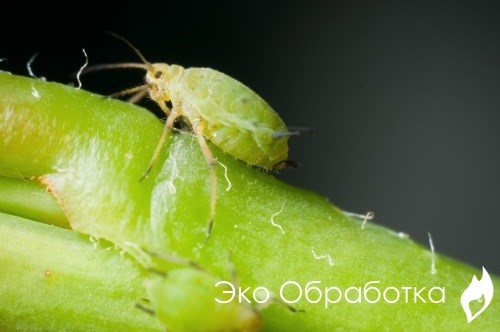

Unlike many other pests, aphids are not bloodthirsty at all. She is a vegetarian and prefers plant juice to any other type of food.Moreover, different species have their own taste preferences and never eat shoots that, in their opinion, are inappropriate. After saturation, the insect expels excess consumed juices. They are called "milk" or padya. The discharge has a sweetish taste and sticky texture, and is especially loved by ants.
Fight against aphids with makhorka and tobacco
An effective remedy is that which has insecticidal properties. For this purpose, tobacco can be used. To scare away aphids, tobacco, tobacco dust, makhorka are suitable. On the basis of the funds, decoctions, infusions, solutions are prepared.
- To make an infusion, you need to grind 200 g of tobacco leaves, pour 5 liters of water over them. Insist for a day. Then pour in 10 liters of water, simmer for about 2 hours.
- To prepare the broth, you need to mix tobacco dust with water (in a ratio of 1:10). Insist the liquid for 2 days, then dilute with water (1: 3) and add soap (one third of the bar).
Compositions in which tobacco is added do well with aphids that attack viburnum. Their greatest accumulation is observed on the branches of the plant. The following remedy will help to destroy parasites: 200 g of tobacco dust or makhorka, 200 g of wood ash, 10 ml of liquid soap, 10 g of mustard powder, pour 2-3 liters of warm water.
Sorry, there are currently no polls available.
In the garden and on the windowsill - favorite habitats
Like any other pest control, aphid treatment involves the use of methods and tools that are relevant to a particular species. For example, its peach varieties live exclusively on fruit trees (plum, apricot, cherry plum), but greenhouse varieties are quite omnivorous and can easily eat peaches, tobacco leaves, and potato tops.
Pome fruit trees infect apple species of this garden pest. In their gluttony, they may well give odds to many other parasites. But, most importantly, these individuals are very dangerous for young shoots.
Green roseanna is a pest with aristocratic manners. Her preferences include rose and rose bushes, as well as strawberries and some stone fruit trees. And leaf gall affects only currant leaves, turning the lush greenery of healthy shoots into a cluster of galls - tumors that can lead to the complete death of the plant.
Cucumber or melon individuals, as their name implies, prefer to choose the surface of the leaves of cucumbers, zucchini, watermelons, melons, tobacco as their habitat. This species is also impressed by exotic citrus trees, eucalyptus, sesame and peanut shoots.
A lover of cruciferous plants is called cabbage aphid. First of all, young shoots of radish and cabbage suffer from it. But phyloxera grape chooses exclusively the vine and leaves of this plant as a source of nutrients. Its appearance threatens the complete destruction of the vineyard within just one season. Conifers also have their own parasites-admirers - Hermes settles on them, the larvae of which are pubescent and look rather exotic.
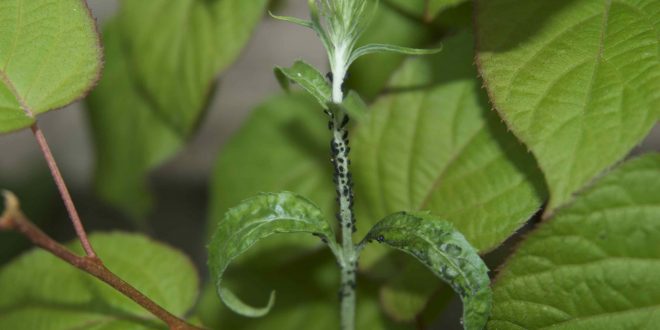

Indoor or domestic subspecies can be black, green, red or white in body color. In this case, adults are omnivorous, do not lay eggs for the winter, but continue their vital activity as usual. Active reproduction of insects leads to the death of shoots, if timely treatment of plants from aphids is not performed.
Ammonia against aphids
Ammonia will help to resist parasites. To prepare the solution, dissolve 2 tbsp in 10 liters of water. l. alcohol, and before the procedure itself, stir another 40 g of soap. After two weeks, the treatment should be repeated.
For a long time, ammonia will help get rid of aphids. They are treated with such plantings:
- roses,
- raspberries,
- pepper,
- dill,
- fruit trees,
- cabbage,
- currants,
- cucumbers,
- viburnum,
- tomatoes and other plants.
In no case should ammonia be used in its pure form, otherwise an excess of nitrogen will lead to the death of leaves and the destruction of chlorophyll. In a liter of cold water, dissolve 5 ml of ammonia. The solution must be thoroughly mixed and a soap base must be added to it. After that, all existing plants can be processed.
Natural enemies of the insect
Any parasite that exists in nature has its natural enemies. In the case of a herbivorous pest that attacks gardens and vegetable gardens from April to October, the main danger is posed by songbirds, in particular blackbirds. To attract them to the garden during the fruiting season of plants usually does not have to make significant efforts.
But in early spring, it is better to feed blackbirds and other birds with the help of specially prepared feeders.
In addition, parasites attract ladybugs, praying mantises, wasters, earwigs, ground beetles, for which they are a natural enemy. To populate the site with a sufficient number of beneficial insects, their eggs can be ordered in special nurseries or garden centers. In particular, in this way, you can purchase lacewings and ladybirds intended for breeding. Wasps also feed on aphids. But to have a hornet's nest on the site is almost more dangerous than pests that damage parts of plants.
Planting the following plants will help attract beneficial insects to the garden:
- umbrella - dill, fennel, tansy;
- mint and lavender;
- clover and alfalfa;
- nightshade (to attract ground beetles);
- daisies (for hover flies).
Pots with sawdust or shavings placed in the immediate vicinity of plant pests infected with a colony will attract an earwig to the site that can effectively destroy a dangerous neighbor.
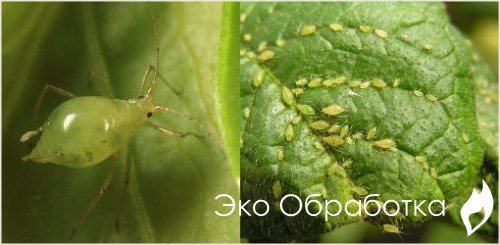

How to treat aphids?
In order for the measures taken to bring about real results, it is worth thinking about waging a struggle on all fronts. For example, it’s worth starting with prevention. Some plant species can act in this capacity. For example, Dolmat chamomile (which contains pyrethrum, an insecticide with high effectiveness), garlic and onions. This parasite traditionally does not really favor them.
Another popular prevention method is planting plants that can divert the attention of pests. Among them are poppy, mallow, kosmeya, some types of begonias, linden. They are planted at some distance from bushes and fruit trees, located at a short distance from melons or beds with nightshades. In the future, such "baits" are mowed down and burned, destroying together with them dangerous garden parasites.
If we talk about the direct fight against insects, the following methods can be distinguished here, during which aphid treatment is performed:
- Biological. With the involvement of natural enemies and biological defense methods. It is not highly effective against established colonies.
- Folk. They imply the mechanical collection and destruction of the pest, as well as the use of various means prepared at home.
- Agrotechnical. This implies the use of a set of measures to reduce the size of the population and reduce the activity of insects. They are usually used in the autumn-spring period.
- Chemical. Insecticidal treatment using household or professional formulations.
Which method is right for you depends on many factors. The main thing is not to miss the moment when an independent struggle turns out to be meaningless and useless. In this case, only the involvement of professionals of the disinsection service will help to correct the situation.
Experts advise: When an aphid colony appears on the site, you should immediately start using the control methods available to you. You should not assume that the troubles will end with the end of the summer season. In the spring, the population can grow, destroying everything in its path. And in this case, it will be too late to apply household insecticides and folk remedies. Only total processing with the involvement of professional equipment and long-acting chemicals will help.
Will folk remedies help?
Treatment of plants from aphids using folk remedies involves the use of both contact and non-contact means. Among the latter, one can mention fumigation with tobacco smoke, which the parasite does not tolerate. Another effective method of control is spraying with a soapy solution with the addition of ash. It is most often used in the processing of nightshades.
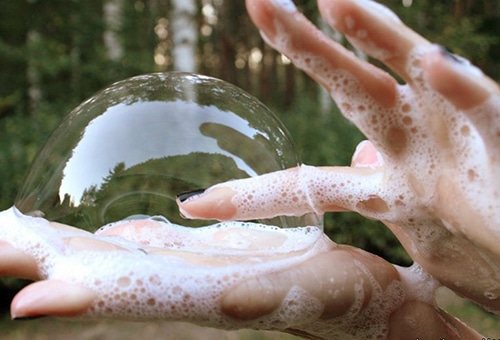

In addition, among the popular folk remedies are:
- spraying with a solution of tar;
- spraying garlic or tobacco infusion;
- spraying with a decoction of marigolds, chamomile or celandine;
- spraying milk-iodine solution;
- spraying fruit trees and shrubs with essential oils of plants such as cloves, lemon or tea trees;
- application of a water-oil suspension to the surface of the leaves.
Of course, folk methods are aimed, rather, at expelling insects from their habitual habitat. At the same time, it is very difficult to guarantee that they will not choose neighboring trees and shrubs for settlement. That is why, having tried these methods, summer residents and homeowners usually switch to using chemicals.
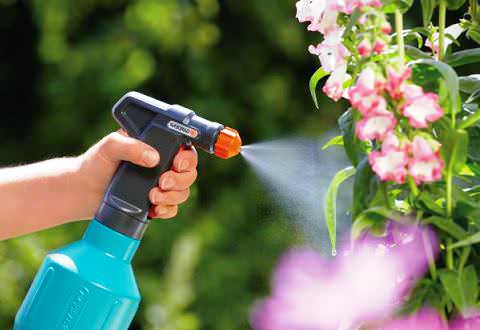

Aphids: species, appearance on the site, possible damage
With the beginning of spring, many gardeners begin to notice the presence of such parasites on their plantations as aphids. Of course, they are interested in where such an attack comes from. The main reason for the appearance of aphids in summer cottages is:
- purchase and planting of infected plants,
- wind transport of insects from neighboring areas,
- transfer of larvae by ants, on animal hair or by people themselves,
- damage to the soil by aphid larvae imported from other sites,
- lack of timely measures for processing plants in the garden or vegetable garden.
If you are determined to fight plant parasites and want to use folk remedies for this, you need to consider that most of them are not able to destroy insects. Their use allows you to scare away uninvited guests.
Spraying should be carried out at least three times, with an interval of 7-10 days. This is best done in the evening on a dry day. If it rains, the procedure is repeated.
To provide prevention, you can use an infusion of wood ash. This means you need to powder the plant. It is prepared as follows: 300 g of ash are poured into 10 liters of water, put on the fire and brought to a boil, 40 g of grated soap is added to the composition before irrigating the plantings.
Outwardly, the insect does not look formidable or impressive. Its fragile body with a weak exoskeleton is damaged by the slightest physical impact, any precipitation or even simple sprinkling can literally wash away the entire colony of aphids, leaving no trace of it.
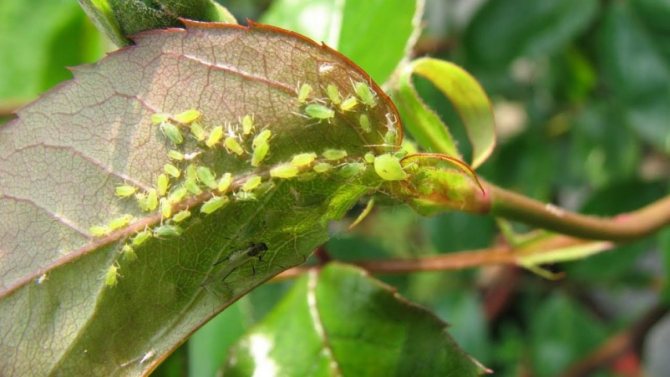

Aphid invasion
Even the ants protecting the aphids living with them in symbiosis are not able to resist predators like ground beetles or ladybirds, who “clean” the trees from aphids literally for several tens of minutes.
But, despite all this, the aphid lives and thrives, since it has a huge advantage that negates all its weaknesses: a short reproductive cycle (several days) and huge fertility, theoretically giving offspring in 3-4 generations of more than one hundred thousand individuals.
Thanks to these factors, the aphid population is able to occupy the entire area of the garden in a matter of days and call into question the high rates of its yield.That is why the fight against aphids is an important task, the relevance of which does not disappear from season to season.
About a third of all aphid species live in Eurasia.
- green
- black
- cotton
- helihrix
The first species is "universal" - representatives of green aphids can be found on almost any plant. These parasites give the greatest preference to fruit trees and shrubs, as well as large perennial flowers.
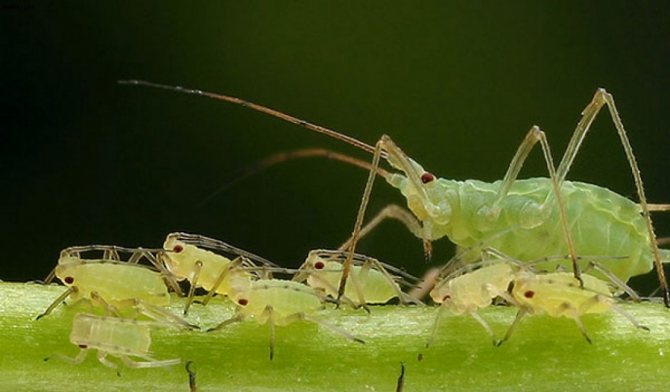

Green aphid
Black aphids predominantly live in vegetable gardens, affecting almost any low vegetation - from beets to legumes.
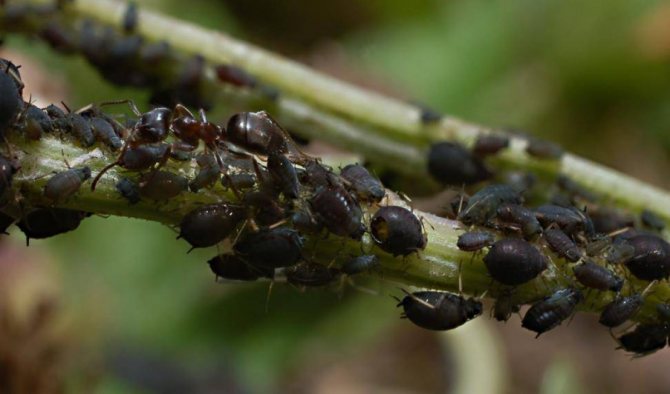

Black aphid
The cotton aphid also belongs to the garden dwellers. It is she who needs to be thanked for the low yields of melons and pumpkin crops. This variety is especially dangerous for cucumbers.
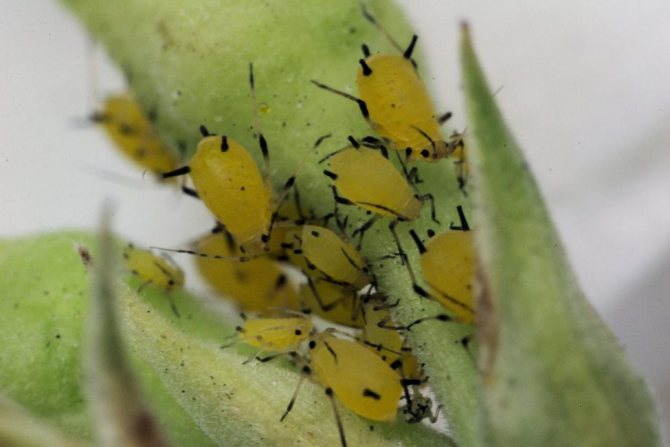

Cotton or melon aphids
The latter variety, gelichris, prefers large-pit crops. First of all, trees of the Plum family are at risk - plum, peach, apricot, etc.
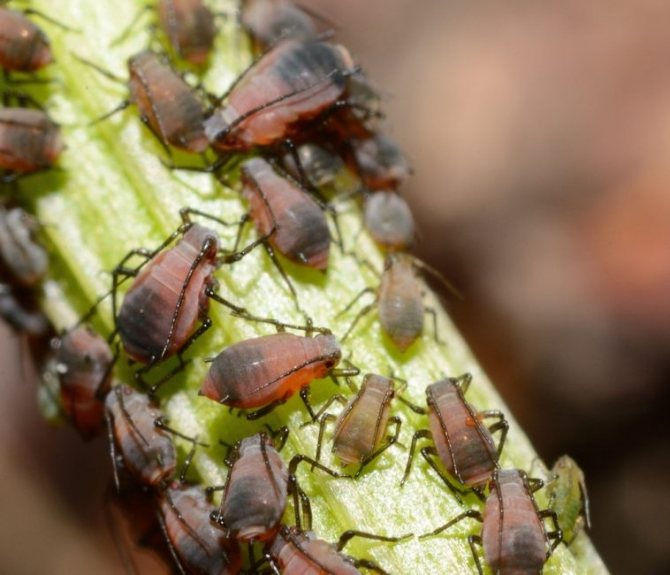

Helichris aphid
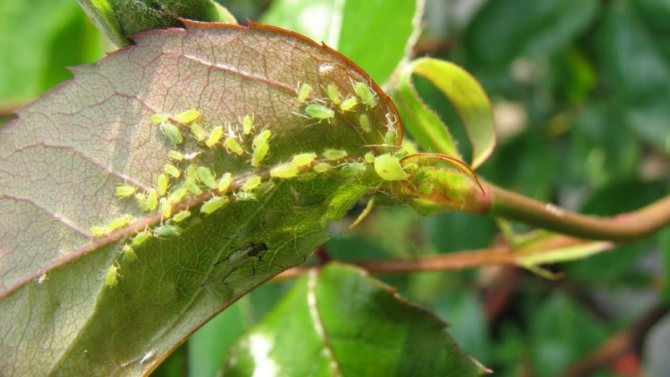

Aphids on garden plants
Usually, during the season, aphids do not migrate. Towards the end of summer, the first males appear in aphids, and subsequent generations may contain both wingless and winged insects, which are already capable of flying from plant to plant.
One of the last generations of aphids lays eggs immediately after the flight to a new place, which overwinter and insects emerge from them in the spring, occupying a new "territory".
Aphid damage
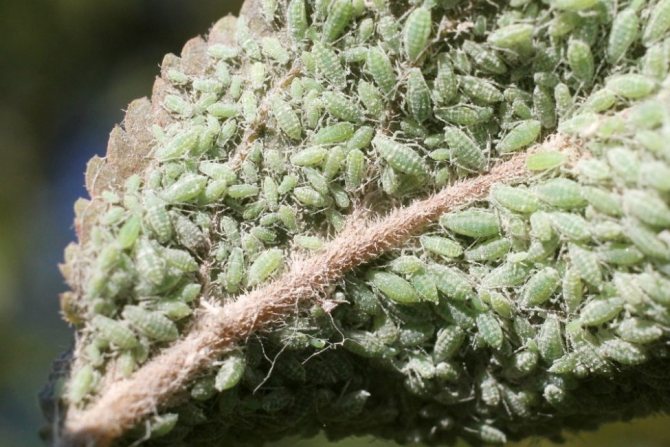

Large pest colony
Aphids are especially dangerous for young plants and shoots. By sucking out nutrients and cellular juices, it can significantly weaken the plant and slow down its growth rate. In addition, aphid saliva is poisonous to the plant.
- foliage of plants curls and deforms
- shoots die off
- growth stops
In addition, viral diseases can be transmitted from plant to plant through the saliva of aphids. If no methods of action against aphids are used, after 2-3 generations it will be possible to forget about a good harvest.
Let's take a look at the various methods currently in use for aphid control.
Agrotechnical methods - as an alternative to chemistry
Treating trees from aphids is only one of the stages of the fight. It is much more important in this case to ensure the prolongation of the effect of the selected methods. Agrotechnical measures for the destruction of this dangerous parasite are aimed at solving this problem. These include weed control. Another precaution is to carefully dig up the soil in the fall and spring. This will allow the detection and destruction of pest eggs.
Changing the localization of plantings is an important element of protecting the site from them. More often it is worth replanting tomatoes, potatoes, melons and gourds. In potato beds, it is also worth planting plants that are natural enemies of aphids.
Another measure of agronomic impact is pruning and disposal of leaves and branches. Affected shoots must be filed or cut and burned. Exposure to fire will leave no chance of survival for larvae and adults. In addition, you should carefully monitor the appearance of ants on the site. They carry insects through the grazing process and help expand their habitat. Accordingly, all participants in this symbiosis will have to be destroyed.
Insecticidal attack on garden parasites
Chemical treatment of aphids with household insecticides can significantly reduce the risks of a rapid increase in the number of individuals in the colony. It is important to take into account that the dosage of the agent in this case must be clearly verified - otherwise not only pests, but also useful gardeners and even birds may suffer. Processing cannot be carried out during the flowering period.It is forbidden to collect fruits from treated trees and shrubs for three to five weeks after pest control.
Among the effective drugs in this case are:
- biological - among the most popular "Fitoverm" in ampoules with the active substance aversectin, belonging to the category of poisons of the intestinal spectrum of action, causing the death of uninvited guests a few days after contact;
- chemical - mainly based on fenoxaprop and mexil ("Jaguar" and its analogues), as well as organophosphorus compounds based on malathion ("Fufanon").
The range of tools for independent use is quite extensive. Among them, you can also find fumigants - substances used to get poison into the body of aphids through the respiratory system. But the most effective options remain systemic solutions that provide complex impact.
Ammonia against aphids
Most gardeners are looking for a universal remedy against aphids on forums on the Internet, but often an effective remedy in one case will give mediocre results in another.
Purchased funds
By purchasing aphid remedies in specialized stores, you can completely get rid of such a pest. Getting rid of parasites of this species is possible thanks to chemical, biological or folk remedies. They differ in the principle of action, but the result is practically the same.
What do the professionals offer?
Performing tasks related to the destruction of dangerous insects is a matter of professionals. It is they who can provide a total cleanup of the site from parasites with a guarantee of protection of the territory from a new visit by uninvited guests a few months after the expiration of the validity of the drugs used.
In addition to specialized insecticides, professionals also use an additional exposure to a finely dispersed spray that generates the so-called "cold" and "hot" fog. Pesticides in the form of solutions are supplied here under pressure, allowing for high speed and efficiency of the treatment being carried out. But, most importantly, the vaporous condensate evenly covers various parts of the plant, facilitating the penetration of the product even into hard-to-reach places.
Another important point is the possibility of using insecticides that are not dangerous to humans and animals. Moreover, if necessary, specialists can select special products that are safe for the useful inhabitants of the garden or do not contain substances to which the owners of the site have allergic reactions.
How and what does it eat?
Each individual is equipped with a piercing proboscis for feeding with plant sap. Some aphids feed on only one type of plant, some on two, and many can suck the juices out of a whole group of suitable plants.
Excess swallowed juice is released in the form of a sticky sugar droplet - honeydew or honeydew (or aphid milk), which ants like to eat.
So ants protect aphids from predators and parasites and can even transfer them to other plants, and in winter they arrange them in an anthill.
"Eco-Processing" on guard of your interests
Turning to, you get an attentive attitude to solving the problems that have arisen, an individual approach to work and the possibility of specialists arriving at the facility as soon as possible. We have at our disposal a whole staff of professionals who are always ready to arrive on call to various cities and districts of the Moscow region. And you can rest assured that help will be timely, quick and effective.
Tired of doing pointless pest control? Just entrust it to professionals who are able to find the right product for their destruction. Just one call, and the dispatcher will accept your order, discussing all the conditions of upcoming cooperation, answer questions and help you understand the effectiveness and degree of danger of the drugs used.
Paying considerable attention to the technical equipment of our specialists, we guarantee high speed when performing work on sites of any area. And we are always glad to offer assistance to both private and corporate clients, agricultural enterprises and farms, providing an affordable cost and a variety of services. You can personally verify the effectiveness of our work. Just call and order a specialist call now.

